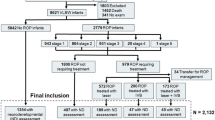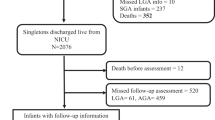Abstract
OBJECTIVES:
To determine risk factors associated with adverse developmental outcome at 5 years in extremely low birth weight infants or extremely premature infants (<28 weeks) with normal neonatal cranial ultrasounds.
DESIGN/METHODS:
Data were collected prospectively on 152 infants with gestation <28 weeks or birth-weight <1000 g. Infants were grouped into those with normal development, mild-to-moderate impairment (IQ 70 to 84, or hearing loss 30 to 89 dB, visual acuity 6/18 to 6/60, or mild/moderate cerebral palsy (CP)) and severe impairment (IQ <70, hearing loss ≥90 dB, visual acuity <6/60, or severe CP).
RESULTS:
Five-year outcomes were available for 144/152 children (95%). In all, 89 (62%) infants had normal development, 39 (27%) had mild–moderate impairment and 16 (11%) had severe impairment. On multivariate logistic regression analysis, factors associated with developmental impairment were serum bilirubin ≥200 μmol/l (odds ratio (OR) – 4.06, p=0.003) and retinopathy of prematurity (ROP) (OR–1.6, p=0.03).
CONCLUSIONS:
A serum bilirubin ≥200 μmol/l and presence of ROP are postnatal risk factors associated with an adverse developmental outcome in infants with normal cranial ultrasounds.
This is a preview of subscription content, access via your institution
Access options
Subscribe to this journal
Receive 12 print issues and online access
$259.00 per year
only $21.58 per issue
Buy this article
- Purchase on Springer Link
- Instant access to full article PDF
Prices may be subject to local taxes which are calculated during checkout
Similar content being viewed by others
References
Rennie JM . Perinatal management at the lower margin of viability. Arch Dis Child 1996;74:F214–F218.
Allen MC, Donohue PK, Dusman AE . The limit of viability — neonatal outcome of infants born at 22 to 25 weeks gestation. N Engl J Med 1993;329:597–1601.
Van de Bor M, Ens-Dokkum M, Schreuder AM, et al. Outcome of periventricular-intraventricular haemorrhage at 5 years of age. Dev Med Child Neurol 1993;35:33–41.
Vohr B, Allan WC, Scott DT, et al. Early-onset intraventricular haemorrhage in preterm neonates: incidence of neurodevelopmental handicap. Semin Perinatol 1999;23 (3):212–217.
Fawer CL, Diebold P, Calame A . Periventricular leukomalacia and neurodevelopmental outcome in preterm infants. Arch Dis Child 1987;62 (1):30–36.
Pidcock FS, Graziani LJ, Stanley C, Mitchell DG, Merton D . Neurosonographic features of periventricular echodensities associated with cerebral palsy in preterm infants. J Pediatr 1990;116:417–422.
Van de Bor M, Ouden LD, Guit GL . Value of cranial ultrasound and magnetic resonance imaging in predicting neurodevelopmental outcome in preterm infants. Pediatrics 1992;90:196–199.
Pinto-Martin JA, Riolo S, Cnaan A, Holzman C, Susser MW, Paneth N . Cranial ultrasound prediction of disabling and nondisabling cerebral palsy at age two in a low birth weight population. Pediatrics 1995;95:249–254.
Majnemer A, Riley P, Shevell M, Birnbaum R, Greenstone H, Coates AL . Severe bronchopulmonary dysplasia increases risk for later neurological and motor sequelae in preterm survivors. Dev Med Child Neurol 2000;42 (1):53–60.
Gray PH, Burns YR, Mohay HA, O'Callaghan MJ, Tudelhope DI . Neurodevelopmental outcome of preterm infants with bronchopulmonary dysplasia. Arch Dis child Fetal Neonatal Ed 1995;73 (30):F128–F134.
O' Shea TM, Kothadia JM, Klinepeter KL, et al. Randomized placebo-controlled trial of a 42-day tapering course of dexamethasone to reduce the duration of ventilator dependency in very low birth weight infants: outcome of study participants at 1-yr adjusted age. Pediatrics 1999;104 (1 Part 1):15–21.
Halliday HL, Ehrenkranz RA . Delayed (>3 weeks) postnatal corticosteroids for chronic lung disease in preterm infants. Cochrane Database Syst Rev 2000; (2):CD001145.
O'Shea TM, Dillard RG, Klinepeter KL, Goldstein DJ . Serum bilirubin levels, intracranial haemorrhage, and the risk of developmental problems in very low birth weight neonates. Pediatrics 1992;90 (6):888–892.
Papile LA, Burstein J, Burstein R . Incidence and evolution of subependymal and intraventricular haemorrhage: a study of infants with birth weights less than 1,500 gm. J Pediatr 1978;92:529–534.
Thorndike RL, Haghen EP, Sattler JM . The Stanford–Binet Intelligence Scale: Guide for Administration and Scoring. 4th edn. Chicago, IL: Riverside publishing Co; 1986.
Wechsler D . Wechsler preschool and primary scales of intelligence — revised. San Antonio, Texas: The Psychological Corporation. Harcourt Brace Jovanovich Inc; 1989.
Lefebvre F, Glorieux J, St-Laurent-Gagnon . Neonatal survival and disability rate at age 18 months for infants born between 23 and 28 weeks of gestation. Am J Obstet Gynecol 1996;174:833–838.
Fanaroff AA, Wright LL, Stevenson DK, et al. Very-low-birth-weight outcomes of the National Institite of Child Health and Human Development Neonatal Research Network, May 1991 through December 1992. Am J Obstet Gynecol 1995;173:1423–1431.
Whitfield MF, Grunau RVE, Holsti L . Extremely premature (≤800 g) schoolchildren: multiple areas of hidden disability. Arch Dis in Child 1997;77:F85–F90.
The Victorian Infant Collaborative Study Group. Neurosensory outcome at five years and extremely low birth weight. Arch Dis of Child 1995;73:F143–F146.
Van De Bor M, Van Zeben-Van Der Aa TM, Verloove-Vanhorick SP, Brand R, Ruys JH . Hyperbilirubinemia in preterm infants and neurodevelopmental outcome at 2 years of age: results of a national collaborative survey. Pediatrics 1989;83:915–920.
Van De Bor M, Ens-Dokkum M, Schreuder AM, Veen S, Brand R, Verloove-Vanhorick SP . Hyperbilirubinemia in low birth weight infants and outcome at 5 years of age. Pediatrics 1992;89 (3):359–364.
Oh W, Tyson JE, Fanaroff AA, et al. Association between peak serum bilirubin and neurodevelopmental outcomes in extremely low birth weight infants. Pediatrics 2003;112 (4):773–779.
Scheidt PC, Graubard BI, Nelson KB, et al. Intelligence at six years in relation to neonatal bilirubin level: follow-up of The National Institute of Child Health and Human Development Clinical Trial of Phototherapy. Pediatrics 1991;87:797–805.
Graziani LJ, Mitchell DG, Kornhauser M, Pidcock FS, Merton DA, Stanley C . Neurodevelopment of preterm infants: neonatal neurosonographic and serum bilirubin studies. Pediatrics 1992;89:229–234.
Cockington RA . A guide to the use of phototherapy in the management of neonatal hyperbilirubinemia. J Paediatr 1979;95:281–297.
Procianoy RS, Garcia-Prats JA, Hittner HM, Adams JM, Rudolph AJ . An association between retinopathy of prematurity and intraventricular haemorrhage in very low birth infants. Acta Paediatr Scand 1981;70:473–477.
Hungerford J, Stewart A, Hope P . Ocular sequelae of preterm birth and their relation to ultrasound evidence of cerebral damage. Br J Ophthalmol 1986;70:463–468.
Doyle L, Davis P . Postnatal corticosteroids in preterm infants: systematic review of effects on mortality and motor function. J Paediatr Child Health 2000;36 (2):101–107.
The Victorian Infant Collaborative Study Group. Postnatal corticosteroids and sensorineural outcome at 5 years of age. J Paediatr Child Health 2000;36 (30):256–261.
Katz-Salamon M, Gerner EM, Jonsson B, Lagercrantz H . Early motor and mental development in very preterm infants with chronic lung disease. Arch Dis Child Fetal Neonatal Ed 2000;83:F1–F6.
Author information
Authors and Affiliations
Rights and permissions
About this article
Cite this article
Sampath, V., Bowen, J. & Gibson, F. Risk Factors for Adverse Neurodevelopment in Extremely Low Birth Weight Infants with Normal Neonatal Cranial Ultrasound. J Perinatol 25, 210–215 (2005). https://doi.org/10.1038/sj.jp.7211228
Published:
Issue Date:
DOI: https://doi.org/10.1038/sj.jp.7211228
This article is cited by
-
Relationships between retinopathy of prematurity without ophthalmologic intervention and neurodevelopment and vision at 2 years
Pediatric Research (2023)
-
Long-term outcomes of children with symptomatic congenital cytomegalovirus disease
Journal of Perinatology (2017)



